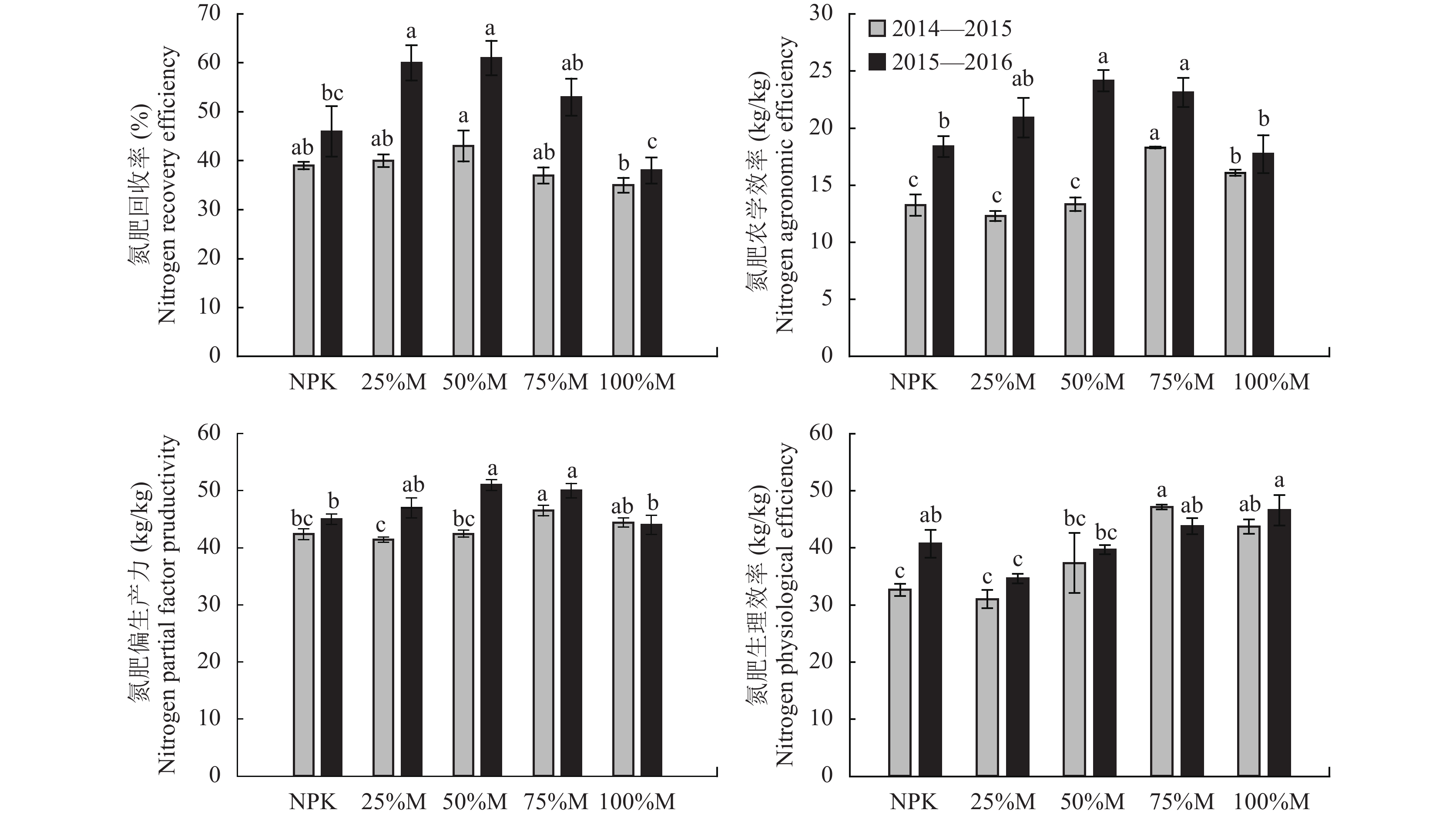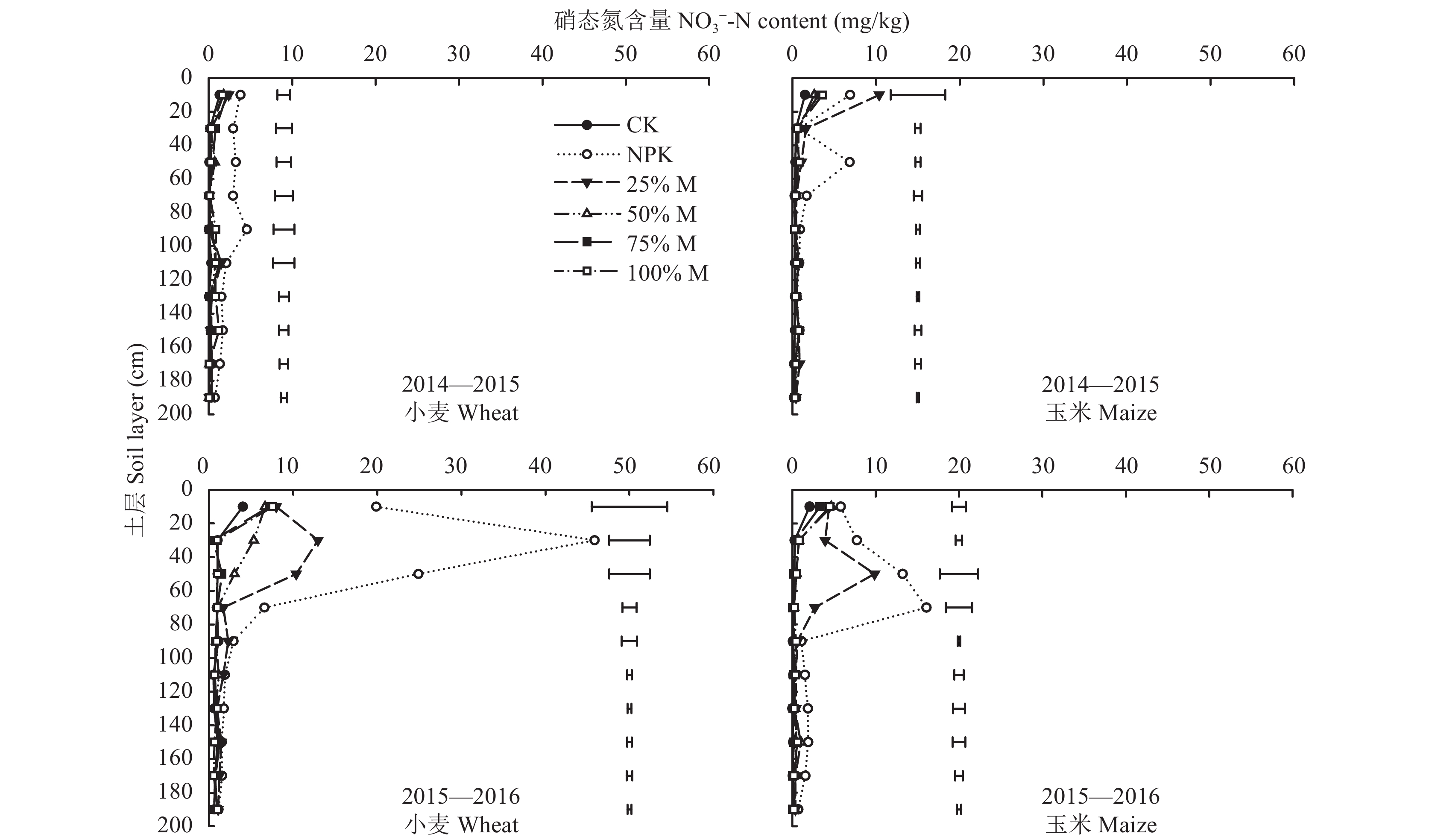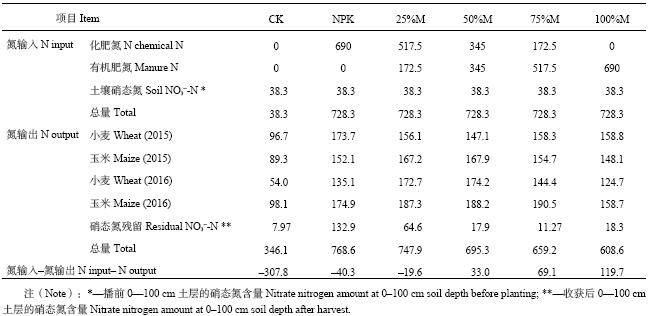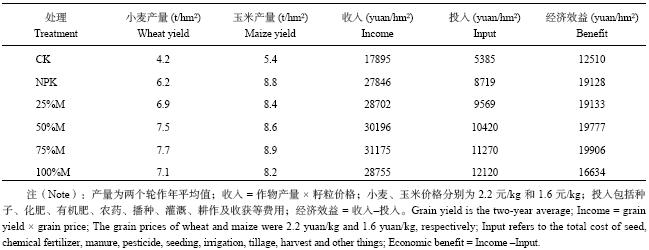2. 西藏山南地区错那县农牧局,西藏山南 856700;
3. 中国农业科学院农业资源与农业区划研究所,北京 100081
2. Agriculture and Animal Husbandry Bureau in Cuona County, Shannan, Tibet 856700, China;
3. Institute of Agricultural Resources and Regional Planning, Chinese Academy of Agricultural Sciences, Beijing 100081, China
小麦–玉米轮作是中国北方重要的农作物种植体系之一,在保证国家粮食安全方面具有重要地位。但是该种植体系下,过量施肥现象非常普遍,就全国而言过量施氮面积可能达20%[1]。如调查显示,大部分地区农民的施肥量普遍超过500 kg/hm2[2],山东省小麦–玉米轮作区平均施氮量为553 kg/hm2[3]。在西北陕西关中平原过量施肥现象同样常见,小麦–玉米轮作中施氮量过高的农户分别占38.5%和64.7%[4]。过量施氮不仅导致氮效率显著降低、农户的生产成本增加,而且显著增加氮素向环境中的排放,引起严重的环境问题,如土体硝酸盐大量残留和淋失[5–6]、温室气体排放[7]以及土壤酸化[8]。因此,在现有农民大量施用化肥的情况下,优化化肥用量以及调整施肥结构 (如有机无机配合) 显得十分必要。
目前,我国的养殖业规模和数量居世界第一位,2010年我国畜禽粪便产生量为22.35亿吨,含有的氮、磷养分量达0.19亿吨和0.04亿吨,分别占氮、磷肥的79%和50%[9]。由于肥料施用由有机肥为主转变为化肥占主导地位,有机肥还田率不足50%,以至于成为现在农业面源污染和农村环境污染的来源[10]。因此,畜禽粪便资源化利用是治理我国农业面源污染和农村环境的重要途径。
增施有机肥是保持土壤生产力和减少化肥施用的一种传统而有效的方法,可以达到节约成本和增加养分有效性的双重作用[11–14]。国内外大量的长期定位试验结果表明化肥配施有机肥显著提高作物产量和改善土壤养分含量[15–26]。不过也有报道表明,过量施用有机肥增产效果不显著,甚至导致较高的土壤氮素残留[27–28]。另外,有机无机配合或有机肥替代无机肥对作物和土壤的影响程度因替代比例、土壤质地及肥力、作物系统、气候以及不同的试验年限存在显著的差异[20, 29]。如刘杏兰等[30]研究表明,随着有机肥替代比例的增加,小麦和玉米产量呈明显的下降趋势;林治安等[31]报道有机肥替代50%无机肥后小麦和玉米产量明显降低。Yang等[32]通过33年的小麦–玉米轮作试验结果表明,试验初期有机无机肥配施对产量没有显著影响,而随着时间的延长其增产效益显著。而邢鹏飞等[33]在华北平原通过连续4年的研究表明,有机肥替代30%无机肥能够保证粮食产量,有机肥替代50%无机肥能提高土壤肥力。因此,不同地区、不同作物系统中,通过有机肥替代多少比例的化肥可达到最佳的产量和养分效率,尤其是替代初期的效应如何,值得进一步探讨。
(土娄)土是陕西关中灌区主要的土壤类型,在以往关于有机氮与化肥氮固定比例 (7∶3) 对土壤肥力以及作物产量的影响的研究[26]中,没有考虑不同比例是否存在显著差异即最佳有机肥替代比例。因此,本试验以陕西关中平原小麦–玉米轮作体系为研究对象,研究(土娄)土有机肥替代化肥比例对小麦和玉米产量、氮效率和氮平衡的影响,为该区小麦–玉米轮作体系合理利用养分资源、减少化肥投入、缓解环境压力提供理论参考。
1 材料与方法 1.1 试验地点本试验在国家黄土肥力和肥料效益监测基地进行,该基地位于黄土高原南部的陕西省关中平原杨凌示范区 (34°17′51″N、108°00′48″E),海拔534 m,年平均气温12.9℃,年降水量为550~600 mm,降雨量主要集中在6至9月份。年均蒸发量993 mm,无霜期184~216天。属于暖温带大陆性季风气候。土壤属土垫旱耕人为土,黄土母质。试验于2014年10月冬小麦播种时开始,至2016年10月夏玉米收获时结束。试验前 0—20 cm土壤有机质含量是15.1 g/kg、有效磷为10.1 mg/kg、速效钾为165.6 mg/kg。
1.2 试验设计小麦–玉米轮作定位试验设置6个处理,以不施肥为对照 (CK),氮磷钾养分100%由化肥提供 (NPK),在小麦–玉米轮作周年总氮素投入量不变的条件下,化肥氮素的25%、50%、75%、100%由有机肥替代,分别记为25%M、50%M、75%M和100%M。每个处理小区面积30 m2,重复3次,随机区组排列。有机肥以及所有磷、钾化肥均于冬小麦播种前一次性基施,有机肥施用量根据当年有机肥的养分分析结果,以全N含量为标准折算,化肥氮分两季施用,NPK处理养分施用量为当地推荐用量[34]。试验施用氮、磷及钾肥为尿素、普通过磷酸钙以及硫酸钾;有机肥为牛粪,2014年施入牛粪的全氮、全磷、全钾含量分别为26.3、9.3、3.9 g/kg;2015年施入牛粪的全氮、全磷、全钾含量分别为29.0、12.7、7.1 g/kg。各处理在小麦和玉米季的实际氮、磷、钾投入量见表1。
| 表1 2014—2016年试验各处理氮磷钾养分施用量 (kg/hm2) Table 1 Total input of nitrogen, phosphorus and potassium in different treatments |
 |
供试小麦和玉米品种分别是小偃22和郑丹958,灌溉、病虫害防治和除草按常规方式进行。本试验始于2014年冬小麦季,试验前种植体系为冬小麦‒夏休闲,第一个轮作年冬小麦于2014年10月8日播种,2015年6月7日收获,夏玉米于2015年6月10日播种,同年10月2日收获;第二个轮作年冬小麦于2015年10月10日播种,2016年6月6日收获,夏玉米于2016年6月9日播种,同年9月29日收获。
1.3 样品采集与分析 1.3.1 土壤样品除了试验开始第一季冬小麦播前采集了0—100 cm土壤剖面外,其他季节冬小麦、夏玉米播种前和收获后,均采集0—200 cm土壤样品,20 cm为一层,测定土壤硝态氮含量。用1 mol/L KCl溶液浸提土样,振荡30 min,过滤后用流动分析仪测定浸提液的氮含量[35]。
1.3.2 植物样品小麦、玉米成熟时每小区选取7.5 m2进行收获,测定生物量以及籽粒产量,并进行考种。同时采集植株样品进行全氮分析。全氮采用浓硫酸–双氧水消解,蒸馏法测定。
1.4 数据计算及统计方法氮偏生产力 (kg/kg) = 施氮处理产量/施氮量;
氮生理效率 (kg/kg) = (施氮区籽粒产量 – 对照区籽粒产量)/(施氮区吸氮量 – 对照区吸氮量);
氮回收率 (%) = (施氮区吸氮量 – 对照区吸氮量)/施氮量 × 100;
土壤硝态氮累积量 (kg/hm2) = 土层厚度 (cm) × 土壤容重 (g/cm3) × 土壤硝态氮含量 (mg/kg)/10;
氮平衡 = 氮输入 – 氮输出,其中氮输入包括氮素施入量和播前硝态氮含量,氮输出包括作物吸收和硝态氮残留[36–37]。
所有数据处理采用Microsoft Excel 2003软件计算各处理的平均数,标准误差,利用SAS 9.2进行显著性分析 (5%显著水平),SigmaPlot 12.5进行作图。
2 结果与分析 2.1 有机肥替代比例对小麦、玉米产量及产量构成要素的影响从两个轮作年结果可知,2015—2016年各施肥处理的产量均高于2014—2015年 (图1)。与对照相比,各施肥处理均显著提高了2014—2015年和2015—2016年两个轮作年的小麦、玉米产量和轮作年总产量;其中2014—2015年轮作年产量增加幅度分别为24%~49%,53%~70%以及42%~60%;2015—2016年轮作年产量增加幅度分别为64%~146%、43%~72%和67%~91%。在不同有机无机配施比例的处理中,随着有机氮替代比例的增加,2014—2015年小麦和玉米产量均表现为75%M处理最高,NPK和其它有机肥配比处理间产量无显著差异,从总产量来看,75%M处理也高于其他配施处理。2015—2016年50%M和75%M处理小麦产量最高,玉米季以NPK处理最高,显著高于100%M以及CK处理,与其他处理差异不显著。总产量表现为50%M和75%M处理显著高于其它处理。
 |
| 图1 2014—2016年不同比例有机无机肥配施下小麦–玉米轮作体系作物产量 Fig. 1 Yields under different treatments for wheat and maize rotation system during 2014–2016 [注(Note):柱内不同字母表示同一年份不同处理间小麦或玉米产量差异达5%显著水平,柱上不同字母表示轮作系统总产量间差异显著Different letters inside bars represent significant difference for yield of maize or wheat among the treatments; letters above the bars represent the rotation system yields were significantly different among the treatments at the 5% level; 误差线为总产量的标准误差Error bars represent standard error for the total yield.] |
施肥对两个轮作年中小麦、玉米产量的三要素影响不同 (表2)。与对照相比,2014—2015年各施肥处理均能显著提高小麦的穗数,其中50%M处理的提高幅度最高 (106.9%),NPK和25%M提高幅度最低 (53.9%)。小麦穗粒数以NPK处理最高,其次为50%M处理,二者均显著高于对照处理,其它处理与对照相似。除了75%M之外,施肥也没有显著影响小麦的千粒重,75%M处理千粒重显著高于对照。在玉米季中,各施肥处理对玉米穗数均无显著影响,而显著提高穗粒数,尤其是75%M处理增加幅度最大;与对照相比,25%M、75%M、100%M处理显著增加了千粒重,提高幅度分别为10.2%、14.5%、13.7%。
2015—2016年,75%M处理小麦穗数显著高于对照处理,而其它处理小麦的穗数与CK相似;施肥处理的穗粒数相似,并显著高于对照;不过所有处理小麦千粒重无显著差异。玉米季施肥处理对穗数和千粒重无显著影响,而显著增加了穗粒数。
| 表2 2014—2016年不同比例有机无机肥配施对小麦、玉米各产量要素的影响 Table 2 Yield components of wheat and maize affected by treatments in 2014–2016 |
 |
从图2可以看出,在2014—2015年小麦–玉米轮作体系中,氮效率的四个指标趋势有所不同。氮回收率的范围在35%~43%之间。50%M处理氮的回收率最高,且显著高于100%M处理,与其他处理无显著差异。不同施肥处理氮农学效率的范围为12.3~18.3 kg/kg,以75%M处理氮农学效率最高,且显著高于其他处理,其次为100%M处理,并显著高于25%M、50%M以及NPK处理。氮偏生产力范围在41.4~46.5 kg/kg之间,其中75%M处理的偏生产力最高,显著高于NPK、25%M和50%M处理。氮生理效率范围为31~47 kg/kg,其中以75%M处理最高,显著高于25%M、50%M以及NPK处理。
在2015—2016轮作年中,随着有机肥替代比例的增加,氮效率的四个指标均表现出先增加后降低的趋势,基本上以有机肥替代50%~75%时,氮效率最高。氮回收率的范围为38%~61%,其中25%M和50%M处理显著高于NPK处理。氮肥农学效率的变化范围为17~24 kg/kg,其中有机肥替代范围在25%~75%时的农学效率高于NPK处理,并且在50%~75%之间达到最大。氮偏生产力在44~51 kg/kg之间变化,与氮农学效率变化趋势相似,有机肥替代50%~75%达到最大。氮生理效率在34~46 kg/kg之间,其中100%M和75%M处理氮生理效率显著高于NPK和25%M处理。总体而言,75%的有机肥替代比例可获得最高的氮效率。
 |
| 图2 2014—2016年不同比例有机无机肥配施下小麦–玉米轮作体系的氮利用效率 Fig. 2 Nitrogen use efficiencies of the wheat and maize rotation system under different treatments in 2014–2016 [注(Note):方柱上不同字母表示同一年度不同处理间差异在5%水平显著Different letters above the bars represent significant differences among the treatments in the same year at the 5% level.] |
2014—2016小麦–玉米两个轮作年中,不同施肥处理在0—200 cm土层的硝态氮残留总量表现大体一致,均为NPK > 25%M > 50%M > 100%M > 75%M > CK。2014—2015年小麦收获后不同施肥处理土壤剖面硝态氮含量均低于5.0 mg/kg,施用有机肥的四个处理土壤剖面硝态氮含量相近,显著低于NPK处理,20、60和100 cm土层的硝态氮残留在不同施肥处理间达到显著差异。玉米收获后,0—20 cm土层硝态氮含量最高,随土层深度增加,硝态氮含量降低,不同施肥处理60 cm土层深度以下硝态氮含量均低于2.0 mg/kg,处理间硝态氮含量均无显著差异,不同施肥处理间仅在40 cm土层的硝态氮含量差异显著。2015—2016年小麦收获后在0—100 cm土层NPK处理硝态氮残留显著高于有机肥配施的处理,并且100 cm土层内不同处理的硝态氮残留量差异达到显著水平。玉米收获后,NPK和25%M处理在100 cm土层内的硝态氮残留量显著高于其他处理 (图3)。
 |
| 图3 2014—2016不同施肥处理小麦、玉米收获期0—200 cm土层土壤硝态氮分布 Fig. 3 Soil NO3–-N contents in different soil layers after harvest of wheat and maize under different treatments during 2014–2016 [注(Note):误差线代表处理间LSD0.05 The error bars represent LSD0.05 value among the treatments.] |
表3显示,小麦–玉米两个轮作年,50%M、75%M和100%M处理均有一定的氮素盈余,盈余量为33~120 kg/hm2,以100%M处理的氮素盈余量最大,25%M和NPK处理氮有一定亏缺,分别为19.6 kg/hm2和40.3 kg/hm2。从硝态氮残留来看,有机无机肥配施均降低硝态氮的残留。
| 表3 2014—2016年不同比例有机无机肥配施下小麦–玉米轮作体系的氮平衡 (kg/hm2) Table 3 Nitrogen balance for the wheat and maize rotation system under different organic N substitution treatments during 2014–2016 |
 |
从2014—2016小麦–玉米两个轮作年的年均经济收益可以看出,施肥处理中75%M处理的年收入最高为31175元/hm2,NPK处理最低 (表4);从投入项来看,由于有机肥价格较高,其替代化肥的比例越高,投入越大,如NPK处理年总投入为8719元/hm2,而100%M处理年总投入为12120元/hm2。综合来看,75%M处理的年收益最大为19906元/hm2,100%M处理的年收益最低为16634元/hm2。
| 表4 2014—2016年不同处理小麦–玉米轮作体系的经济效益分析 Table 4 Economic analysis under different treatments for wheat and maize rotation system during 2014–2016 |
 |
从陕西关中(土娄)土小麦–玉米两个轮作年的试验结果来看,有机肥替代75%化肥较单施化肥优化了产量三要素构成,进而显著增加了作物总产量,而其它比例有机肥替代的作物总产量与单施化肥相当。国内外关于有机替代适宜比例的研究结果不同,如Subehia等[22]报道50%农家肥代替化肥较单施化肥显著增加了水稻产量,而25%替代与单施化肥相同;而Kumar[38]报道在试验开始的前三年有机肥替代25%~50%的化肥均导致水稻减产,随后有机替代处理与单施化肥处理水稻产量相当。在我国山东省棕壤的一个3年试验研究结果显示有机肥替代25%或50%可以获得与单施化肥相似的小麦、玉米产量,继续提高有机肥比例导致作物减产[39],另外一个4年的试验发现30%或50%的有机肥替代在前两年可以获得与单施化肥相似的小麦、玉米产量,后两年30%有机肥替代显著提高了小麦产量[33]。鲁耀雄等[40]报道有机肥替代30%较单施化肥显著提高湖南晚稻的产量,而其他替代比例与单施化肥相当;林治安等[31]报道有机肥替代50%化肥可以获得与单施化肥相同的小麦、玉米产量,100%有机肥处理在开始15年作物产量均低于单施化肥。不同试验结果的差异性可能与土壤本身的肥力状况、气候条件等有关。有机肥本身的速效养分含量有限,需要通过微生物矿化分解释放养分,而微生物的生物量以及活性与土壤肥力和水热等环境因素密切相关。当土壤肥力水平较低时,微生物的繁殖和生长会与作物竞争养分,影响作物吸收养分,进而影响产量[41]。如棕壤的中低产田,不施肥处理小麦和玉米年总产量为6.5 t/hm2,25%有机肥替代获得与单施化肥相当的产量,继续增加有机替代比例会降低作物产量[39]。因此,低肥力土壤有机肥替代比例要低。当土壤肥力水平较高时,有机替代比例提高有利于微生物繁殖和生长、提高其活性,促进无机养分的有机固持,同时满足作物生长,有利于增加产量。如高肥力稻田有机肥替代比例可达70%,仍能维持与单施化肥相当的产量[42]。本研究对照处理两年的作物产量为9166~10049 kg/hm2,表明土壤初始肥力水平较高,因此,高比例有机肥替代 (如75%) 获得了最大的产量效益和经济效益。
有机肥替代化肥的增产效果是一个综合的效应。这与有机肥增加养分有效性、含有生物活性物质[15, 19]、可以刺激作物生长有关;另外有机肥施用还可以改善土壤物理性质[18]。不过从国内外的研究来看,有机替代基本上是有机氮替代化肥氮,各个研究均存在磷、钾用量不一致的情况[22, 33, 38–39, 42]。在本试验中有机肥处理的磷投入量均高于NPK处理,NPK处理年用量为P2O5150 kg/hm2,本地区小麦季P2O5推荐用量为60~140 kg/hm2[34],玉米季推荐用量为30~80 kg/hm2[43]。因此,本试验NPK处理磷用量是合理的,有机替代的增产效果应该是由其它因素引起的,而非磷投入量差异的结果。
3.2 不同有机无机肥配施对小麦/玉米轮作体系氮效率的影响氮肥回收利用率、农学效率、氮肥偏生产力以及生理效率是衡量氮素效率的常用指标,从不同方面描述作物对氮素的吸收利用[44]。Dobermann[45]认为粮食作物氮肥回收利用率为30%~50%,氮肥农学效率为10~30 kg/kg,氮肥偏生产力为40~70 kg/kg,氮肥生理效率为30~60 kg/kg较为适宜。本研究结果表明,不同比例有机无机肥配施处理的四种氮肥效率均介于上述适宜范围内,说明该研究设置的施氮量水平在适宜范围内,并且氮磷钾平衡施用,不论氮素来源如何,都有较好的养分效率[40]。从氮肥农学效率和氮肥回收效率两个指标来看,本试验小麦和玉米的氮肥效率和世界粮食作物主产区农户常规施肥管理的氮肥效率平均水平相当[46],却远远低于其他一些国家和地区在试验条件下所得到的氮肥农学效率 (20~25 kg/kg) 和氮肥回收利用率 (40%~60%)[47]。另外,有研究认为,当氮肥偏生产力大于60 kg/kg时,表明氮素管理较好或施肥量较低[48],但本试验各个处理的氮肥偏生产力均未达到60 kg/kg,这可能是因为本试验的施氮量虽然在适宜范围内,可能仍然存在进一步优化的空间或者进一步提高籽粒产量的空间。
本研究随着有机肥施入比例的增加,氮效率总体呈现先增加后降低的趋势,其中75%有机肥替代化肥氮素效率最高。究其原因,主要是施用有机肥可以改善土壤的物理、化学以及生物学性质[49–50],促进根系生长[51],提高了作物产量,促进了作物对氮素的吸收[52],最终提高氮效率。
3.3 不同比例有机无机肥配施对小麦–玉米轮作氮平衡的影响分析农田氮素平衡,不仅可以掌握作物对施氮的反应动态,而且还可以了解土壤氮素盈余状况及肥料氮去向,为指导农业生产提供依据。有研究显示,土壤不同层次残留硝态氮的作物有效性随着土层深度的增加而显著降低[53],小麦和玉米根系可以利用0—100 cm土层的硝态氮,而难以利用100 cm土层以下的硝态氮[54]。基于试验开始时土壤硝态氮测定深度为100 cm,因此,氮素表观平衡基于0—100 cm土层计算。
从对照处理的氮平衡可知,试验两年土壤矿化以及环境输入氮素进入农田系统共计308 kg/hm2。据报道本试验所在地杨凌,每年氮沉降量约32 kg/hm2[55],那么土壤矿化以及灌溉水的氮素供应每年超过120 kg/hm2,原因是灌溉水含氮量较低,而且灌溉量有限。因此,土壤矿化提供了主要的氮素,表明试验土壤肥力水平较高。根据以往的研究结果[34, 43, 56],本试验设计小麦–玉米轮作年合理的施氮量为345 kg/hm2,氮输出项中作物的氮素携出占主要部分 (表2),但是单施化肥处理两个轮作年后硝态氮残留达133 kg/hm2,可以预见未来可能存在硝态氮淋失以及反硝化损失,加之土壤自身供氮水平较高,因此在单施化肥的情况下年推荐量N 345 kg/hm2仍然偏高,有进一步降低的空间。而有机肥替代处理硝态氮残留量较低,说明适量有机肥的施入有利于增加土壤微生物数量及活性[49–50],增加微生物对矿质态氮素的固持作用[57],从而抑制其在土壤剖面中累积[58]。
4 结论陕西关中(土娄)土小麦/玉米轮作体系经过两个轮作年不同比例有机肥替代化肥试验,综合分析产量、氮效率、年经济收益以及土体硝态氮的残留量,在年施氮量为345 kg/hm2时,有机肥替代75%化肥较单施化肥可以显著提高作物产量、氮效率,减少土壤中硝态氮的残留。不过随着有机肥的长期施用、土壤肥力的进一步提高,适宜的有机肥替代比例可能会发生变化,这将有待于进一步的研究观测。
| [1] |
巨晓棠, 谷保静. 我国农田氮肥施用现状, 问题及趋势[J].
植物营养与肥料学报, 2014, 20(4): 783–795.
Ju X T, Gu B J. Status-quo, problem and trend of nitrogen fertilization in China[J]. Journal of Plant Nutrition and Fertilizer, 2014, 20(4): 783–795. DOI:10.11674/zwyf.2014.0401 |
| [2] | Cui Z L, Chen X P, Zhang F S. Current nitrogen management status and measures to improve the intensive wheat-maize system in China[J]. Ambio, 2010, 39(5-6): 376–384. DOI:10.1007/s13280-010-0076-6 |
| [3] |
寇长林, 巨晓棠, 张福锁. 三种集约化种植体系氮素平衡及其对地下水硝酸盐含量的影响[J].
应用生态学报, 2005, 16(4): 660–667.
Kou C L, Ju X T, Zhang F S. Nitrogen balance and its effects on nitrate-N concentration of groundwater in three intensive cropping systems of North China[J]. Chinese Journal of Applied Ecology, 2005, 16(4): 660–667. |
| [4] |
常艳丽, 刘俊梅, 李玉会, 等. 陕西关中平原小麦/玉米轮作体系施肥现状调查与评价[J].
西北农林科技大学学报, 2014, 42(8): 51–61.
Chang Y L, Liu J M, Li Y H, et al. Investigation and evaluation of fertilization under winter wheat and summer maize rotation system in Guanzhong Plain, Shaanxi Province[J]. Journal of Northwest A&F University, 2014, 42(8): 51–61. |
| [5] | Ju X T, Xing G X, Chen X P, et al. Reducing environmental risk by improving N management in intensive Chinese agricultural systems[J]. Proceedings of the National Academy of Sciences, 2009, 106(9): 3041–3046. DOI:10.1073/pnas.0813417106 |
| [6] | Zhou J, Gu B, Schlesinger W H, et al. Significant accumulation of nitrate in Chinese semi-humid croplands[J]. Scientific Reports, 2016, 6: 25088. DOI:10.1038/srep25088 |
| [7] | Zhang W F, Dou Z X, He P, et al. New technologies reduce greenhouse gas emissions from nitrogenous fertilizer in China[J]. Proceedings of the National Academy of Sciences, 2013, 110(21): 8375–8380. DOI:10.1073/pnas.1210447110 |
| [8] | Guo J H, Liu X J, Zhang Y, et al. Significant acidification in major Chinese croplands[J]. Science, 2010, 327(5968): 1008–1010. DOI:10.1126/science.1182570 |
| [9] |
耿维, 胡林, 崔建宇, 等. 中国区域畜禽粪便能源潜力及总量控制研究[J].
农业工程学报, 2013, 29(1): 171–179.
Geng W, Hu L, Cui J Y, et al. Biogas energy potential for livestock manure and gross control of animal feeding in region level of China[J]. Transactions of the Chinese Society of Agricultural Engineering, 2013, 29(1): 171–179. |
| [10] |
王森, 焦瑞峰, 马艳华, 等. 我国畜禽粪便综合利用途径研究[J].
河南科技学院学报(自然科学版), 2017, 45(1): 20–24.
Wang S, Jiao R F, Ma Y H, et al. The comprehensive utilization of livestock and poultry manure in China[J]. Journal of Henan Institute of Science and Technology (Natural Science Edition), 2017, 45(1): 20–24. |
| [11] | Rasmussen P E, Goulding K W T, Brown J R, et al. Long-term agroecosystem experiments: assessing agricultural sustainability and global change[J]. Science, 1998, 282(5390): 893–896. DOI:10.1126/science.282.5390.893 |
| [12] | Fan M, Shen J, Yuan L, et al. Improving crop productivity and resource use efficiency to ensure food security and environmental quality in China[J]. Journal of Experimental Botany, 2012, 63(1): 13–24. DOI:10.1093/jxb/err248 |
| [13] | Misselbrook T H, Menzi H, Cordovil C. Preface-recycling of organic residues to agriculture: Agronomic and environmental impacts[J]. Agriculture, Ecosystems & Environment, 2012, 160: 1–2. |
| [14] | Rosegrant M W, Koo J, Cenacchi N, et al. Food security in a world of natural resource scarcity: The role of agricultural technologies [M]. International Food Policy Research Institute, 2014. |
| [15] | Ai C, Liang G, Sun J, et al. Responses of extracellular enzyme activities and microbial community in both the rhizosphere and bulk soil to long-term fertilization practices in a fluvo-aquic soil[J]. Geoderma, 2012, 173: 330–338. |
| [16] | Maillard, Angers D A. Animal manure application and soil organic carbon stocks: A meta-analysis[J]. Global Change Biology, 2014, 20(2): 666–679. DOI:10.1111/gcb.2014.20.issue-2 |
| [17] | Lu F E I, Wang X, Han B, et al. Soil carbon sequestrations by nitrogen fertilizer application, straw return and no-tillage in China's cropland[J]. Global Change Biology, 2009, 15(2): 281–305. DOI:10.1111/gcb.2009.15.issue-2 |
| [18] | Rasool R, Kukal S S, Hira G S. Soil organic carbon and physical properties as affected by long‒term application of FYM and inorganic fertilizers in maize-wheat system[J]. Soil and Tillage Research, 2008, 101(1): 31–36. |
| [19] | Demelash N, Bayu W, Tesfaye S, et al. Current and residual effects of compost and inorganic fertilizer on wheat and soil chemical properties[J]. Nutrient Cycling in Agroecosystems, 2014, 100(3): 357–367. DOI:10.1007/s10705-014-9654-5 |
| [20] | Yang Z C, Zhao N, Huang F, et al. Long-term effects of different organic and inorganic fertilizer treatments on soil organic carbon sequestration and crop yields on the North China Plain[J]. Soil and Tillage Research, 2015, 146: 47–52. DOI:10.1016/j.still.2014.06.011 |
| [21] | Krschens M, Albert E, Armbruster M, et al. Effect of mineral and organic fertilization on crop yield, nitrogen uptake, carbon and nitrogen balances, as well as soil organic carbon content and dynamics: results from 20 European long-term field experiments of the twenty-first century[J]. Archives of Agronomy and Soil Science, 2013, 59(8): 1017–1040. DOI:10.1080/03650340.2012.704548 |
| [22] | Subehia S K, Sepehya S, Rana S S, et al. Long-term effect of organic and inorganic fertilizers on rice (Oryza sativa L.) yield, and chemical properties of an acidic soil in the western Himalayas [J]. Experimental Agriculture, 2013, 49(3): 382–394. DOI:10.1017/S0014479713000173 |
| [23] |
王飞, 林诚, 李清华, 等. 长期不同施肥方式对南方黄泥田水稻产量及基础地力贡献率的影响[J].
福建农业学报, 2010, 25(5): 631–635.
Wang F, Lin C, Li Q H, et al. Effects of long-term fertilization on rice yield and contribution rate of basic soil productivity on the yellow paddy of southern China[J]. Fujian Journal of Agricultural Sciences, 2010, 25(5): 631–635. |
| [24] |
张云贵, 刘宏斌, 李志宏, 等. 长期施肥条件下华北平原农田硝态氮淋失风险的研究[J].
植物营养与肥料学报, 2005, 11(6): 711–716.
Zhang Y G, Liu H B, Li Z H, et al. Study of nitrate leaching potential from agricultural land in Northern China under long-term fertilization conditions[J]. Plant Nutrition and Fertilizer Science, 2005, 11(6): 711–716. DOI:10.11674/zwyf.2005.0601 |
| [25] |
徐明岗, 于荣, 孙小凤, 等. 长期施肥对我国典型土壤活性有机质及碳库管理指数的影响[J].
植物营养与肥料学报, 2006, 12(4): 459–465.
Xu M G, Yu R, Sun X F, et al. Effects of long-term fertilization on labile organic matter and carbon management index (CMI) of the typical soils of China[J]. Plant Nutrition and Fertilizer Science, 2006, 12(4): 459–465. DOI:10.11674/zwyf.2006.0401 |
| [26] | Yang X Y, Sun B H, Zhang S L. Trends of yield and soil fertility in a long-term wheat-maize system[J]. Journal of Integrative Agriculture, 2014, 13(2): 402–414. DOI:10.1016/S2095-3119(13)60425-6 |
| [27] | Seufert V, Ramankutty N, Foley J A. Comparing the yields of organic and conventional agriculture[J]. Nature, 2012, 485(7397): 229–232. DOI:10.1038/nature11069 |
| [28] | Trewavas A. Urban myths of organic farming[J]. Nature, 2001, 410(6827): 409–410. DOI:10.1038/35068639 |
| [29] | Liang Q, Chen H, Gong Y, et al. Effects of 15 years of manure and inorganic fertilizers on soil organic carbon fractions in a wheat-maize system in the North China Plain[J]. Nutrient Cycling in Agroecosystems, 2012, 92(1): 21–33. DOI:10.1007/s10705-011-9469-6 |
| [30] |
刘杏兰, 高宗, 刘存, 等. 有机‒无机肥配施的增产效应及对土壤肥力影响的定位研究[J].
土壤学报, 1996, 33(2): 138–147.
Liu X L, Gao Z, Liu C, et al. Effects of combined application of organic manure and fertilizers on crop yield and soil fertility in a located experiment[J]. Acta Pedologica Sinica, 1996, 33(2): 138–147. DOI:10.11766/trxb199407060204 |
| [31] |
林治安, 赵秉强, 袁亮, 等. 长期定位施肥对土壤养分与作物产量的影响[J].
中国农业科学, 2009, 42(8): 2809–2819.
Lin Z A, Zhao B Q, Yuan L, et al. Effects of organic manure and fertilizers long-term located application on soil fertility and crop yield[J]. Scientia Agricultura Sinica, 2009, 42(8): 2809–2819. |
| [32] | Yang J, Gao W, Ren S. Long-term effects of combined application of chemical nitrogen with organic materials on crop yields, soil organic carbon and total nitrogen in fluvo-aquic soil[J]. Soil and Tillage Research, 2015, 151: 67–74. DOI:10.1016/j.still.2015.03.008 |
| [33] |
邢鹏飞, 高圣超, 马鸣超, 等. 有机肥替代部分无机肥对华北农田土壤理化特性, 酶活性及作物产量的影响[J].
中国土壤与肥料, 2016, (3): 98–104.
Xing P F, Gao S C, Ma M C, et al. Impact of organic manure supplement chemical fertilizer partially on soil nutrition, enzyme activity and crop yield in the north China plain[J]. Soil and Fertilizer Sciences in China, 2016, (3): 98–104. DOI:10.11838/sfsc.20160316 |
| [34] |
付莹莹, 同延安, 李文祥, 等. 陕西关中灌区冬小麦土壤养分丰缺指标体系的建立[J].
麦类作物学报, 2009, 29(5): 897–900.
Fu Y Y, Tong Y A, Li W X, et al. Establishment of soil nutrient index system for winter wheat in Guanzhong irrigation areas of Shaanxi Province[J]. Journal of Triticeae Crops, 2009, 29(5): 897–900. |
| [35] |
鲁如坤. 土壤农业化学分析方法[M]. 北京: 中国农业科技出版社, 2000.
Lu R K. Methods of soil and agricultural chemistry analysis [M]. Beijing: China Agricultural Science and Technology Press, 2000. |
| [36] |
崔振岭, 石立委, 徐久飞, 等. 氮肥使用对冬小麦产量、品质和氮素表观损失的影响研究[J].
应用生态学报, 2005, 16(11): 2071–2075.
Cui Z L, Shi L W, Xu J F, et al. Effects of N fertilization on winter wheat grain yield and its crude protein content and apparent N losses[J]. Chinese Journal of Applied Ecology, 2005, 16(11): 2071–2075. DOI:10.3321/j.issn:1001-9332.2005.11.012 |
| [37] |
石玉, 于振文. 施氮量及底追比例对小麦产量、土壤硝态氮含量和氮平衡的影响[J].
生态学报, 2006, 26(11): 3661–3670.
Shi Y, Yu Z W. Effects of nitrogen fertilizer rate and ratio of base and topdressing on yield of wheat, content of soil nitrate and nitrogen balance[J]. Acta Ecologica Sinica, 2006, 26(11): 3661–3670. DOI:10.3321/j.issn:1000-0933.2006.11.019 |
| [38] | Kumar A. Use of organic manure and fertilizer in rice (Oryza sativa)-wheat (Triticum aestivum) cropping system for sustainability [J]. Indian Journal of Agricultural Sciences, 1995, 65(10): 703–707. |
| [39] |
李占, 丁娜, 郭立月, 等. 有机肥和化肥不同比例配施对冬小麦/夏玉米生长, 产量和品质的影响[J].
山东农业科学, 2013, 45(7): 71–77.
Li Z, Ding N, Guo L Y, et al. Effects of different ratios of organic manure and chemical fertilizer on growth, yield and quality of winter wheat and summer maize[J]. Shandong Agricultural Sciences, 2013, 45(7): 71–77. |
| [40] |
鲁耀雄, 崔新卫, 范海珊, 等. 有机无机肥配施对湖南省晚稻生长, 产量及土壤生物学特性的影响[J].
中国土壤与肥料, 2015, (5): 50–55.
Lu Y X, Cui X W, Fan H S, et al. Effects of combined application of manure and chemical fertilizer on the growth and yield of rice and soil biological characters in paddy soils[J]. Soil and Fertilizer Sciences in China, 2015, (5): 50–55. |
| [41] | Khaliq A, Abbasi M K, Hussain T. Effects of integrated use of organic and inorganic nutrient sources with effective microorganisms (EM) on seed cotton yield in Pakistan[J]. Bioresource Technology, 2006, 97(8): 967–972. DOI:10.1016/j.biortech.2005.05.002 |
| [42] |
周江明. 有机-无机肥配施对水稻产量、品质及氮素吸收的影响[J].
植物营养与肥料学报, 2012, 18(1): 234–240.
Zhou J M. Effect of combined application of organic and mineral fertilizers on yield, quality and nitrogen uptake of rice[J]. Plant Nutrition and Fertilizer Science, 2012, 18(1): 234–240. DOI:10.11674/zwyf.2012.11186 |
| [43] |
付莹莹, 同延安, 赵佐平, 等. 陕西关中灌区夏玉米土壤养分丰缺及推荐施肥指标体系的建立[J].
干旱地区农业研究, 2010, 28(1): 88–93.
Fu Y Y, Tong Y A, Zhao Z P, et al. The establishment of soil nutrient abundance and fertilizer recommendation index system for summer maize in Guangzhong Irrigation Areas, Shaanxi Province[J]. Agricultural Research in the Arid Areas, 2010, 28(1): 88–93. |
| [44] |
彭少兵, 黄见良, 钟旭华, 等. 提高中国稻田氮肥利用率的研究策略[J].
中国农业科学, 2002, 35(9): 1095–1103.
Peng S B, Huang J L, Zhong X H, et al. Research strategy in improving fertilizer-nitrogen use efficiency of irrigated rice in China[J]. Scientia Agricultura Sinica, 2002, 35(9): 1095–1103. |
| [45] | Dobermann A R. Nitrogen use efficiency-state of the art [A]. IFA international workshop on enhanced efficiency fertilizers[C]. Frankfurt, Germany, 2005. |
| [46] | Cassman K G, Dobermann A, Walters D T. Agroecosystems, nitrogen-use efficiency, and nitrogen management[J]. Ambio: A Journal of the Human Environment, 2002, 31(2): 132–140. DOI:10.1579/0044-7447-31.2.132 |
| [47] | Ladha J K, Pathak H, Krupnik T J, et al. Efficiency of fertilizer nitrogen in cereal production: retrospects and prospects[J]. Advances in Agronomy, 2005, 87: 85–156. DOI:10.1016/S0065-2113(05)87003-8 |
| [48] | Dobermann A, Dawe D, Roetter R P, et al. Reversal of rice yield decline in a long-term continuous cropping experiment[J]. Agronomy Journal, 2000, 92: 633–643. DOI:10.2134/agronj2000.924633x |
| [49] |
许小伟, 樊剑波, 陈晏, 等. 不同有机无机肥配施比例对红壤旱地花生产量, 土壤速效养分和生物学性质的影响[J].
生态学报, 2014, 34(18): 5182–5190.
Xu X W, Fan J B, Chen Y, et al. Effects of combined application of organic and chemical fertilizers on the yield of peanut, soil available nutrient and biological properties in the upland red soil in subtropical China[J]. Acta Ecologica Sinica, 2014, 34(18): 5182–5190. |
| [50] | Zhao J, Ni T, Li J, et al. Effects of organic-inorganic compound fertilizer with reduced chemical fertilizer application on crop yields, soil biological activity and bacterial community structure in a rice-wheat cropping system[J]. Applied Soil Ecology, 2016, 99(18): 1–12. |
| [51] | Saikia P, Bhattacharya S S, Baruah K K. Organic substitution in fertilizer schedule: Impacts on soil health, photosynthetic efficiency, yield and assimilation in wheat grown in alluvial soil[J]. Agriculture, Ecosystems & Environment, 2015, 203: 102–109. |
| [52] |
张广凯, 宋祥云, 刘树堂, 等. 长期定位施肥对小麦-玉米氮素利用及产量品质的影响[J].
华北农学报, 2015, 30(4): 157–161.
Zhang G K, Song X Y, Liu S T, et al. Effect of long-term application on nitrogen utilization and yield quality of wheat and maize[J]. Acta Agricultura Boreal-Sinica, 2015, 30(4): 157–161. DOI:10.7668/hbnxb.2015.04.027 |
| [53] | Zhang L J, Ju X T, Zhang F S, Peng Z P. Movement and residual effect of labeled nitrate-N in different soil layers[J]. Scientia Agricultura Sinica, 2007, 40(9): 1964–1972. |
| [54] | Ju X T, Liu X J, Zhang F S. Study on effect of nitrogen fertilizer and nitrogen balance in winter wheat and summer maize rotation system[J]. Scientia Agricultura Sinica, 2002, 35(11): 1361–1368. |
| [55] |
魏样, 同延安, 段敏, 等. 陕北典型农区大气干湿氮沉降季节变化[J].
应用生态学报, 2010, 21(1): 255–259.
Wei Y, Tong Y A, Duan M, et al. Atmospheric dry and wet nitrogen deposition in typical agricultural areas of North Shaanxi[J]. Chinese Journal of Applied Ecology, 2010, 21(1): 255–259. |
| [56] |
张树兰, 同延安. 冬小麦–夏玉米轮作氮肥施量与氮营养诊断[J].
西北农业学报, 2000, 9(2): 104–107.
Zhang S L, Tong Y A. Recommendation of nitrogen fertilizer and nitrogen nutritional diagnosis in wheat-corn rotation[J]. Acta Agriculturea Boreali‒Occidentalis Sinica, 2000, 9(2): 104–107. |
| [57] |
李娟, 赵秉强, 李秀英, 等. 长期有机无机肥料配施对土壤微生物学特性及土壤肥力的影响[J].
中国农业科学, 2008, 41(1): 144–152.
Li J, Zhao B Q, Li X Y, et al. Effects of long-term combined application of organic and mineral fertilizers on soil microbiological properties and soil fertility[J]. Scientia Agricultura Sinica, 2008, 41(1): 144–152. |
| [58] |
杨学云, 张树兰, 袁新民, 等. 长期施肥对塿土硝态氮分布、累积和移动的影响[J].
植物营养与肥料学报, 2001, 7(2): 134–138.
Yang X Y, Zhang S L, Yuan X M, et al. A long-term experiment on effect of organic manure and chemical fertilizer on distribution, accumulation and movement of NO3--N in soil [J]. Plant Nutrition and Fertilizer Science, 2001, 7(2): 134–138. |
 2018, Vol. 24
2018, Vol. 24  doi:
doi: 

